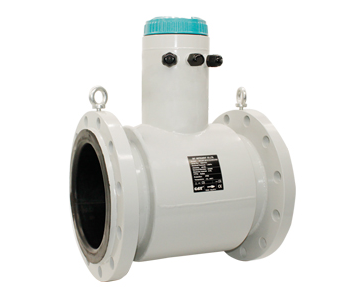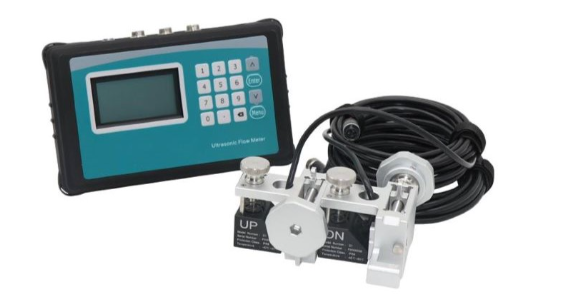Drain Flow Meter
2024-06-17
1. Type of flow meter
Drainage pipe flowmeters are mainly divided into electromagnetic flowmeters, ultrasonic flowmeters and differential pressure flowmeters. Among them, electromagnetic flowmeter is widely used in drainage pipe flow measurement because of its accurate measurement and good stability. Ultrasonic flowmeter has become a type of flowmeter that has attracted much attention in recent years because of its non-contact measurement and suitable for large diameter pipelines. Differential pressure flowmeter calculates the flow rate by measuring the pressure difference between the two ends of the pipe, which is suitable for large diameter pipelines.
2. Measurement principle
(1) Electromagnetic flow meter: Based on Faraday's law of electromagnetic induction, the flow is calculated by measuring the induced electromotive force of the conductive liquid in the magnetic field. (2) Ultrasonic flow meter: The use of ultrasonic in the liquid propagation speed and the relationship between the flow, by measuring the ultrasonic propagation time to calculate the flow. (3) Differential pressure flow meter: Based on Bernoulli equation, the flow rate is calculated by measuring the pressure difference between the two ends of the pipe. 3. Applicable pipe size
3. Applicable pipe size
Different types of flowmeters are suitable for different pipe sizes. In the use of drainage pipe flow timing, in general, the electromagnetic flowmeter is suitable for DN15 to DN6000 pipelines; Ultrasonic flowmeter is suitable for DN50 to DN4000 pipeline; Differential pressure flowmeters are suitable for larger diameter pipes, such as DN1000 to DN10000.
4. Measuring range
The measuring range of each type of flowmeter varies according to factors such as its design principle, manufacturing process and use environment. Generally speaking, the measuring range of the electromagnetic flowmeter can reach 0.01m³/h to 10,000 m³/h; The measuring range of the ultrasonic flowmeter is generally 0.5m³/h to 10,000 m³/h; The differential pressure flowmeter has a large measuring range, generally 10m³/h to 100000m³/h.
5. Accuracy level
The accuracy class of the flowmeter refers to the accuracy of its measurement results. Different types of flowmeters have different accuracy levels. In general, the accuracy of electromagnetic flowmeters and ultrasonic flowmeters can reach ±0.5%R or higher; The accuracy level of differential pressure flowmeters is generally ±1%R to ±5%R.
6. Output signal type
The output signal type of the flowmeter mainly has two kinds of analog signal and digital signal. Analog signals such as 4-20mA, 0-10V, etc., while digital signals are based on Modbus, Profibus and other communication protocols. Select the appropriate output signal type according to the requirements of the user and the control system.
7. Installation requirements
(1) The flow meter should be installed on the straight pipe section to avoid being installed in the elbow, valve and other places where eddy currents are generated.
(2) The installation direction of the flowmeter should be consistent with the flow direction of the fluid in the pipeline.
(3) When installing, ensure that the connection between the flow meter and the pipeline is tight to prevent water leakage and fluid leakage.
(4) Excessive mechanical and thermal stress on the flowmeter should be avoided during installation.
8. Maintenance and maintenance
(1) Clean the drainage pipe flowmeter regularly to remove dirt and impurities accumulated on the surface.
(2) Check whether the cables, joints and other parts of the flow meter are intact, and replace them in time if damaged.
(3) Regularly calibrate the drainage pipe flowmeter to ensure its measurement accuracy.
(4) During use, attention should be paid to avoid the impact of harsh environments such as strong magnetic field and high temperature on the flowmeter.
Through the introduction of the above aspects, I believe you have a more comprehensive understanding of the drainage pipe flowmeter. In practical applications, please select the appropriate flowmeter type according to the specific needs and conditions, and install it in strict accordance with the installation requirements to ensure its normal operation and measurement accuracy.
If you want to know more about the flow meter or flow meter selection, please consult the Aister flow meter manufacturer email: sales@aistermeter.com for help.
Drainage pipe flowmeters are mainly divided into electromagnetic flowmeters, ultrasonic flowmeters and differential pressure flowmeters. Among them, electromagnetic flowmeter is widely used in drainage pipe flow measurement because of its accurate measurement and good stability. Ultrasonic flowmeter has become a type of flowmeter that has attracted much attention in recent years because of its non-contact measurement and suitable for large diameter pipelines. Differential pressure flowmeter calculates the flow rate by measuring the pressure difference between the two ends of the pipe, which is suitable for large diameter pipelines.
2. Measurement principle
(1) Electromagnetic flow meter: Based on Faraday's law of electromagnetic induction, the flow is calculated by measuring the induced electromotive force of the conductive liquid in the magnetic field. (2) Ultrasonic flow meter: The use of ultrasonic in the liquid propagation speed and the relationship between the flow, by measuring the ultrasonic propagation time to calculate the flow. (3) Differential pressure flow meter: Based on Bernoulli equation, the flow rate is calculated by measuring the pressure difference between the two ends of the pipe.

Different types of flowmeters are suitable for different pipe sizes. In the use of drainage pipe flow timing, in general, the electromagnetic flowmeter is suitable for DN15 to DN6000 pipelines; Ultrasonic flowmeter is suitable for DN50 to DN4000 pipeline; Differential pressure flowmeters are suitable for larger diameter pipes, such as DN1000 to DN10000.
4. Measuring range
The measuring range of each type of flowmeter varies according to factors such as its design principle, manufacturing process and use environment. Generally speaking, the measuring range of the electromagnetic flowmeter can reach 0.01m³/h to 10,000 m³/h; The measuring range of the ultrasonic flowmeter is generally 0.5m³/h to 10,000 m³/h; The differential pressure flowmeter has a large measuring range, generally 10m³/h to 100000m³/h.
5. Accuracy level
The accuracy class of the flowmeter refers to the accuracy of its measurement results. Different types of flowmeters have different accuracy levels. In general, the accuracy of electromagnetic flowmeters and ultrasonic flowmeters can reach ±0.5%R or higher; The accuracy level of differential pressure flowmeters is generally ±1%R to ±5%R.
6. Output signal type
The output signal type of the flowmeter mainly has two kinds of analog signal and digital signal. Analog signals such as 4-20mA, 0-10V, etc., while digital signals are based on Modbus, Profibus and other communication protocols. Select the appropriate output signal type according to the requirements of the user and the control system.
7. Installation requirements
(1) The flow meter should be installed on the straight pipe section to avoid being installed in the elbow, valve and other places where eddy currents are generated.
(2) The installation direction of the flowmeter should be consistent with the flow direction of the fluid in the pipeline.
(3) When installing, ensure that the connection between the flow meter and the pipeline is tight to prevent water leakage and fluid leakage.
(4) Excessive mechanical and thermal stress on the flowmeter should be avoided during installation.
8. Maintenance and maintenance
(1) Clean the drainage pipe flowmeter regularly to remove dirt and impurities accumulated on the surface.
(2) Check whether the cables, joints and other parts of the flow meter are intact, and replace them in time if damaged.
(3) Regularly calibrate the drainage pipe flowmeter to ensure its measurement accuracy.
(4) During use, attention should be paid to avoid the impact of harsh environments such as strong magnetic field and high temperature on the flowmeter.
Through the introduction of the above aspects, I believe you have a more comprehensive understanding of the drainage pipe flowmeter. In practical applications, please select the appropriate flowmeter type according to the specific needs and conditions, and install it in strict accordance with the installation requirements to ensure its normal operation and measurement accuracy.
If you want to know more about the flow meter or flow meter selection, please consult the Aister flow meter manufacturer email: sales@aistermeter.com for help.
Share To:
Previous Post:
Next Post:
News
- Why is the thermal gas mass flowmeter not affected by pressure strength and temperature?
- What to do when a thermal gas mass flow meter fails?
- How are thermal gas mass flow meters used? What are the applications?
- Under what circumstances is the gas measurement need to be regulated compensated vortex flowmeter
- Why Is The Aister Thermal Gas Mass Flowmeter So Popular ?
- Gas turbine flowmeter manufacturers explain their main advantages in measurement
- Gas turbine flowmeter manufacturer Aister instrument field experience summary
- Aister Instrument Empowerment Conference










